what tire compound to use on dirt go karts
When it comes to racing go-karts, tires are an extremely important component that are often undervalued. Equipping your become-kart with the right tire size, blazon and compound can make or break your racing performance.
As become-kart tires perform differently depending on the track atmospheric condition, your go-kart, track surface type and various other factors, they tin can greatly impact your lap times.
In fact, it tin be a difference of coming in starting time identify or finishing somewhere in the eye of the pack. Therefore, the aim of this guide is to share valuable information on go-kart tires ranging from types and sizes to compounds and costs.
Here are the topics of what this get-kart tire guide will cover:
- Types
- Sizes
- Compounds
- Costs
- Manufacturers
- Prep
- FAQs
In this guide, I'll share my personal feel with go-kart tires and include extended inquiry that I accept done. I'll likewise be sharing information that was gathered from professional go-kart racers that I have met and collaborated with forth the way.
Types
Selecting the correct type of become-kart tires is one of the central tasks that you'll be confronted with before a race. Each get-kart tire type is designed for a specific application (type of race or become-kart) and performs differently depending on track conditions.
For example, slick tires are designed to provide maximum grip during normal and dry out runway conditions, whereby wet tires are optimized to perform well during moisture and damp track conditions.
Each tire type features different compounds, threads, sizes and are designed for different applications. In the section below, we'll go through each tire type in a little more than detail.
Slick Tires
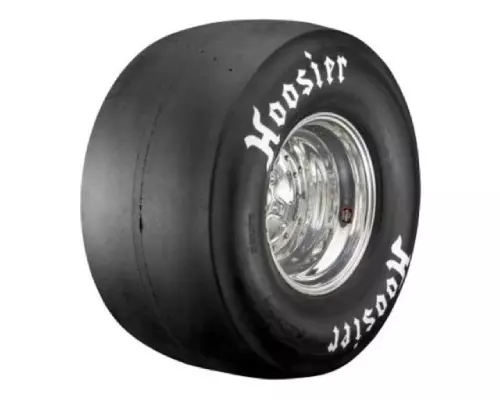
- For dry track conditions
- Difficult, medium, soft chemical compound
- CIK-FIA homologated
- Multiple kart classes
- Non-threaded tires
Slick tires are standard go-kart racing tires that are designed with a smooth thread and optimized for maximum grip in dry weather atmospheric condition. Manufacturers typically offering three unlike compounds for slick get-kart tires, which are soft, medium and hard.
Soft tires yield the most grip simply wearable out the fastest, whereby difficult tires last the longest but compromise on grip. Medium compound racing tires are typically the center ground. Observe out more well-nigh tire compounds here.
High-end slick tires are typically CIK-FIA homologated and are designed to be used in competitive go-kart races. Not-homologated slick tires are sometimes referred to equally sport tires.
Slick tires for become-karts are narrow in the front (nearly 3.5" to 5") and wider in the rear (about vi" to 8"). Staggered tires sizes help to induce understeer and conform for the increased weight towards the back of the go-kart.
Wet Tires
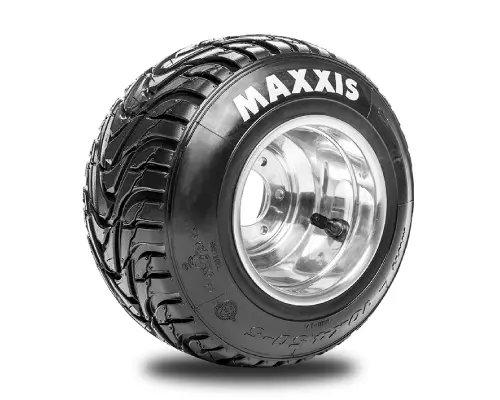
- For wet rail atmospheric condition
- Hard, medium, soft chemical compound
- CIK-FIA homologated
- Multiple kart classes
- Threaded tires
Wet tires, also called rain tires, are used for go-kart races with wet or clammy track conditions. When it rains, water accumulates on the rails surface and acts every bit a layer betwixt the rail and the become-kart tire.
Therefore, go-kart tires for wet atmospheric condition are typically threaded. Threaded tires take grooves on the surface that are designed to prevent aquaplaning (likewise known as hydroplaning) by pushing water away from the tires.
Similarly, wet tires can be CIK-FIA homologated for racers who participate in competitive races or not-homologated for non-competitive racing. It's also mutual to take a staggered setup for wet tires.
Oval Tires
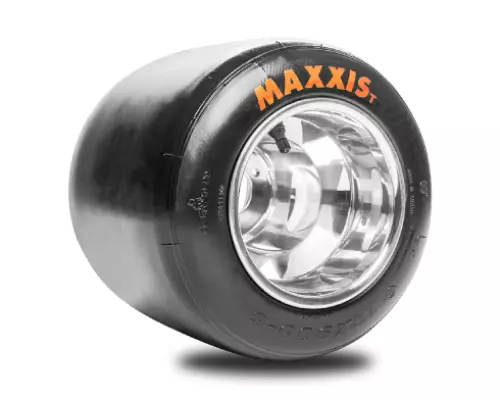
- Designed for oval karting
- For oval clay and asphalt tracks
- Typically wider tires
- Stiffer sidewalls
Oval tires are non named after the shape of the tire, but after their application: oval kart racing. Oval racing tires are designed for oval karts and are available in threaded and non-threaded versions.
Compared to slick tires, oval tires are much wider and are typically designed with a stiffer sidewall to adjust for increased grip when racing around an oval runway.
Depending on the type of oval become-kart and track type, tire manufacturers typically design oval tires for asphalt or clay oval race tracks. Oval tires are more than common in the United states and are typically non-homologated.
Dirt/Off-Road Tires
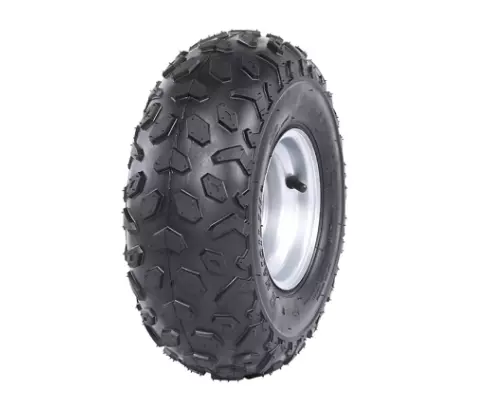
- Designed for clay & off-road racing
- Thread blueprint
- Higher ground clearance
- Knobby contour
Dirt tires for get-karts are likewise referred to equally off-road tires and are designed for dirt or off-road racing. These tires are typically much larger and aren't every bit wide as slick or oval tires.
While it's true that wider tires with a larger surface surface area provide more grip, dirt tires are often narrower but larger in size. This type of tire design facilitates a higher ground clearance and increased maneuverability, which is essential for off-route racing.
Dirt tires are typically threaded or knobby, which is platonic for racing on unstable or unlevel terrains such equally dirt, grass, mud and sand. Mostly speaking, dirt tires for go-karts are not homologated.
Concession Tires
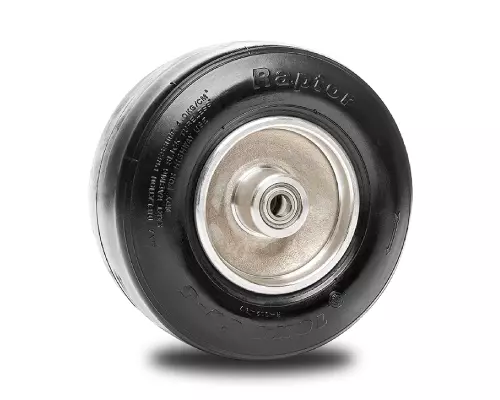
- For rental karts
- Affordable
- Mass produced
- Built to concluding
Concession tires for get-karts are designed specially for rental get-karts. They are frequently hard compound tires with a thicker construction, as they are built to last longer than slick tires.
These tires are also designed for indoor employ and commonly achieve a heart ground between performance and affordability. Concession tires are not CIK homologated and are often tubed for increased lifespan.
Sizes
Get-kart tires come up in different shapes and sizes, which are typically predicated on their application. For example, slick and oval tires are optimized for grip and therefore have a wider structure.
On the other hand, off-road tires are knobby and have a much greater height and narrower width. Get-kart tires are attributed with height, width and rim bore (case: 11 x 6.00 – 5).
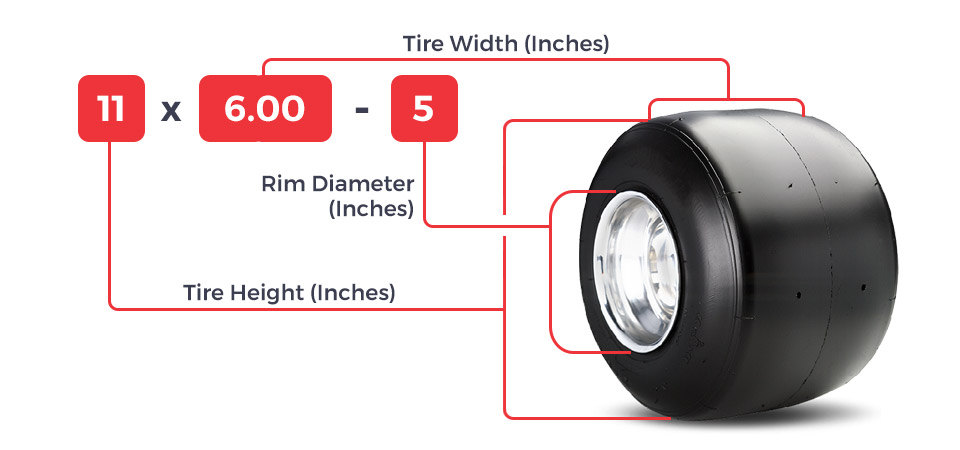
The illustration above will assist you better sympathise where and how you can place the tire sizes. There are diverse aspects to this so brand sure to read the guide on how to read become-kart tire sizes.
Compounds
Get-kart tires are ordinarily fabricated from the following ingredients: polymers which are natural prophylactic, synthetic rubber (produced from petroleum-derived hydrocarbons), carbon black and various oils.
The ingredients of go-kart tires are adequately like across manufacturers and are mixed in a specific ratio depending on the type of tire. A tire compound also determines the 'hardness' or 'softness' of a go-kart tire.
More specifically, they don't necessarily measure the 'hardness' of the tire itself, simply more of its interaction with the race track. Go-kart racing tires have three types of compound levels: hard, soft, and medium.
- Difficult Tires – Hard compound tires are stiffer and don't offering equally much grip every bit medium or soft compound tires. This is considering less surface area makes contact with the race track. However, hard tires are designed to last longer and also have a lower rolling resistance.
- Soft Tires – Soft compound tires are made of softer rubber assuasive more of the tire to brand contact with the race track, assuasive for more grip. Notwithstanding, soft tires tend to wear faster and accept a college rolling resistance, but are designed to provide more grip.
- Medium Tires – Medium compound tires offering a center signal in terms of tire grip, rolling resistance and vesture. They are often regarded equally the "safe option" when information technology comes to selecting the right tires for a get-kart race.
The chemical compound that is best for your go-kart depends on the rails layout, your go-kart and the track conditions. Generally speaking, softer tires offer more grip but are more than expensive and take a loftier rolling resistance, whereas harder tires are more than affordable, have less grip just wear less.
Costs
The price of go-kart tires depends on the manufacturer, also equally its type, size and compound. Become-kart tires typically cost about $xxx to $100 for a single tire and a set of four goes for almost $120 to $400.
Of course the actual price may also depend on where you decide to purchase your go-kart tires (retailed, market or directly with the manufacturer). Used go-kart tires are frequently heavily discounted and can be found on places similar eBay for about $40 – $150 for used sets for four.
- Search: Used Get-Kart Tires on eBay
Manufacturers
There are diverse get-kart tire manufacturers, which are predominantly located in the United States and in Europe. Manufacturers typically offer a broad range of go-kart tires for various go-kart types and runway conditions.
Please make sure to cheque out the go-kart tire size nautical chart from various manufacturers. There, you'll be able to run across their tire range, likewise as the dimensions and other important details. Beneath, you'll find a list of the best go-kart tire manufacturers:
Maxxis
Maxxis was founded in 1967 and has been importing kart tires in the U.s. since 1997. They distribute kart racing tires all around the globe and pride themselves in having a close relationship with track owners, promoters and drivers. Hither is their line-upwards:
- Maxxis Sprint (slick, moisture and racing tires)
- Maxxis Dirt (oval tires)
- Maxxis Concession (concession tires)
Hoosier
Hoosier is an American visitor that was founded past Bob Newton and his wife who started manufacturing racing tires in Indiana, United States. Today, Hoosier offers more than 1,000 different tires and are known for their loftier-quality go-kart tires, exporting globally.
- R55 (slick tires)
- R60A (slick tires)
- R60B (slick tires)
- R70 (slick tires)
- R80 (slick tires)
- WET (wet tires)
Vega
Vega was founded in 1980 and produces a wide range of go-kart tires. With production plants in Italy and France, they offering slick, wet and concession tires. Their speciality are CIK-FIA homologated tires and the squad works closely with their team of drivers. It's also worth noting that each tire goes through at least 200 laboratory checks. Here is their offering:
- Vega Slick (slick tires)
- Vega Pelting (wet tires)
- Vega Rental (concession tires)
Dunlop
The Dunlop go-kart tire range is known as Dunlop Kartsport and features 4 different series. They offering more than 60 different sizes across their range and mainly manufacture slick and wet tires. While they're focused on homologated tires, they can likewise exist used for leisure karting. Below, y'all'll find their complete range
- DF Series (slick tires)
- KT Series (wet tires)
- SL Series (slick tires)
- DE Series (slick tires)
MOJO
MOJO tires were initially developed in guild to cater for Rotax 125 course engines. These go-kart tires are manufactured in Dresden, Germany and offer slick and wet tires for various karting classes. In 2006, MOJO tires were widely commercialized and are now available in more than l countries. Here's a summary of the tires they take on offer:
- D2XX (slick tires)
- D5 (slick tires)
- W5 (moisture tires)
- C2 (slick tires)
- CW (slick tires)
MG Tires
Some other popular go-kart tire manufacturer is MG Tires, which was founded in 1989 in Brazil. They use PAHs (polycyclic effluvious hydrocarbons) to craft CIK-FIA homologated and non-homologated racing tires. They offering a broad range of go-kart tires and work closely with track operators and drivers. Here'south a list of become-kart tires that are available:
- SM Series (slick tires)
- SH Series (slick tires)
- SW Series (moisture tires)
- SC Series (slick tires)
- SCW Series (wet tires)
- SS (slick tires)
- SI (slick tires)
- AZ (slick tires)
- SD (off-route tires)
- RL1 (concession tires)
- RL2 (concession tires)
- RL3 (concession tires)
LeCont
Founded past the two brothers Sergio and Valter Cont, LeCont get-kart tires have established themselves as an Italian manufacturer that produces high-quality racing tires. All of their tires are CIK-FIA approved and homologated. Here's a closer look at their exceptionally large tire range:
- SVA Serial (slick tires)
- SVB Series (slick tires)
- SVC Series (slick tires)
- SV1 Series (wet tires)
- SV2 Series (wet tires)
- LH03 Series (slick tires)
- LH05 Serial (slick tires)
- 4S Series (slick tires)
- LH04 Serial (wet tires)
- MSA04 Series (all weather tires)
Tire Prep
Tire prep formulas are designed to increase the traction of your become-kart tires on the race track. This added traction is able to increment the "stickiness" of your tires on the track'due south surface, which typically results in faster lap times, due to the increased grip around the corners and during acceleration.
I've written a comprehensive guide on how to tire prep your go-kart tires effectively. In this guide I've also shared some additional tips that y'all should definitely check out.
If y'all're looking for a tire prep formula that'due south set-made, and then feel free to check out the best go-kart tire prep formulas, where I rank and review the all-time prep formulas on the market.
Of import Note: Please note that tire pro formulas are not allowed to be used in go-kart races that are organized and sanctioned past the CIK-FIA. To ensure compliance to racing rules and regulations, always check with the event or race organizer.
Frequently Asked Questions
In this department, I'll be addressing some of the most frequently asked questions on go-kart tires. If at that place are some questions that yous accept which are not on the listing, feel free to write in and I'll be happy to add them into this list and reply them!
What Are the Best Tires for My Go-Kart?
There is no overall best go-kart tire for every situation that anyone will exist able to propose to you. Your selection criteria of racing tires should be based on your go-kart, too as the track and weather conditions.
However, here's a quick guide of their benefits and when it may exist all-time to choose one of the other:
- Oval Tires: For oval races
- Slick Tires: For dry weather weather
- Wet Tires: For moisture weather conditions
- Dirt Tires: For off-route and dirt races
- Concession Tires: For rental go-karts
In terms of compound, you may use below as a guide for your selection. Ensure to practise some practice rounds if you can, every bit you'll definitely experience a difference in handling (specially around corners).
- Difficult Compound: Less grip, lasts longer
- Soft Compound: More than grip, wears faster
- Medium Chemical compound: middle footing
Where Tin can I Buy Go-Kart Tires?
Get-kart tires are available in various places. Yous'll be able to purchase new and used tires from retailers, online marketplaces, classified ads and manufacturers directly.
Here are some places y'all can look at:
- Amazon
- eBay
- Craigslist
- Walmart
- BMI Karts
- Kart Parts Depot
- GoPowerSports
- Facebook Marketplace
Where Do I Find the Correct Tire Size?
If yous're looking to notice the right tire size for your go-kart, make sure that yous check out the become-kart tire size chart. In that location, you lot'll be able to notice a list of manufacturers and their available series and respective tire sizes.
How Long Practise Become-Kart Tires Terminal
The lifespan of your get-kart tires depends on various aspects such as brand, quality, track abrasiveness, driving style, go-kart and usage. Therefore, depending on the above mentioned factors, become-kart tires tin last between 2 – 3 races on average. You can definitely run them for longer, simply you'll notice a performance loss.
Have note that the longer you use your go-kart tires the less grip they somewhen offer, which can touch on your lap times. Firstly, they wear over fourth dimension and secondly due to oestrus cycling.
How Many Sets of Go-Kart Tires Do I Need?
This depends on your racing habit and how seriously you lot take get-kart racing. Ultimately, you should take enough sets of tires so that you lot don't run out when racing. Here's a simple practice that I follow for outdoor racing:
- ane prepare of four tires on my go-kart
- 2 sets of 4 slick tires every bit spare
- 1 prepare of four moisture tires for wet conditions
- 1 set of all-weather tires (optional)
How Much Do I Need to Spend on Get-Kart Tires?
The amount y'all'll need to spend on go-kart tires depends how oft yous demand to replace them. Professional go-kart racers detect themselves spending anywhere between $15,000 to $25,000 a year on new go-kart tires.
Semi-professionals or occasional racers spend near $5,000 to $10,000 a year on new sets of become-kart tires. However, if you're on a budget you can supercede your tires less often and also opt for used tires. You'll probably get away with about $2,000 to $3,000 yearly.
Source: https://www.gokartguide.com/go-kart-tires/
0 Response to "what tire compound to use on dirt go karts"
ارسال یک نظر